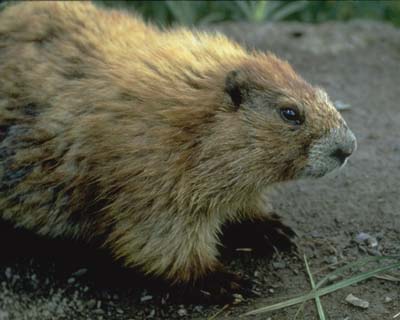Cultivating the Power of the Burrowing Rodent
I can still remember my uncle sitting on his porch with a shotgun, determined to get the woodchuck that was decimating his garden. As I was very young, I marveled that he could sit quiet and still for such a long time. One man against one woodchuck. My money was on the woodchuck.
A woodchuck is a ground squirrel of the marmot family, also known as a groundhog and sometimes lumped into the catchall term for burrowing rodents, gopher, though technically a gopher refers to the Pocket Gopher of the northern Plains states. Whatever it is that answers to the name “gopher,” whether it’s a Pocket Gopher or a prairie dog or a groundhog or some other marmot, it’s still a vegetarian with a voracious appetite. Gophers decimate crops, compete with livestock for vegetation, and ruin vegetable gardens. They interfere with human engineering by piling up dirt where it isn’t wanted. Like all rodents, they sometimes carry diseases.
Gophers play an important role in the ecology, however, and eliminating gophers as pests causes many more problems than it solves. Their tunneling serves to channel snow and heavy rain back underground, reducing flash floods and standing water. They also aerate and enrich the soil, eliminating their waste underground and bringing deep soil to the surface. Foxes, snakes, skunks and many other small predators make their homes in abandoned groundhog houses, and these animals pray on mice and rats. (Foxes eat the groundhogs, too.) While prairie dogs do eat some of the same grasses as cattle or sheep, their foraging habits tend to diversify grassland, which actually benefits domestic animals. It’s only when prairie dog colonies explode that they cause a problem: prairie dog towns have been known to house several thousand pups over many acres of grassland. The rancher brought the prairie dog dilemma on himself, though, by exterminating the wolf and reducing coyote populations.
Prairie dogs live in “coteries” that will include a male and several females with their young, with the pups taking up residence close by. Quickly the town grows. Prairie dogs need to be highly social to manage life in a small town, and they communicate with a collection of chatter, whistles, clucks and barks that some linguists consider a true language. They also communicate by what looks like a kiss.
On the opposite end of the spectrum is the Pocket Gopher. Like most individuals who spend their free time in their apartments, the Pocket Gopher is a solitary creature. Mother kicks dad out of house soon after mating, and the youngsters mature quickly, then wander off.
Marmots are somewhere in between in sociability. The groundhog is monogamous, at least for a season, while the Western marmots live in harems. The youngsters like to box and wrestle. Marmot communication includes chatter, squeals, barks and a whistle that sounds a lot like a bird song. This gives marmots their other nickname of “whistle pigs.”
But marmots are not pigs and groundhogs are not hogs and prairie dogs are not dogs and, as mentioned before, it’s a bone of contention what is and isn’t a gopher. Even the word “woodchuck,” derived from an Algonquian word for another animal, is a misnomer, since they don’t chuck any wood. If you are allied with the burrowing squirrels, people will be confused about who you are or think they know who you are when they don’t.
The groundhog, like the snake, inhabits all three sections of the World Tree: the roots, the trunk, and the upper branches. Yes, groundhogs climb trees. They also swim. The ability to travel comfortably in many environments gives the groundhog, and women who cultivate groundhog energy, the power of discernment. They can understand the implication of events on many levels.

